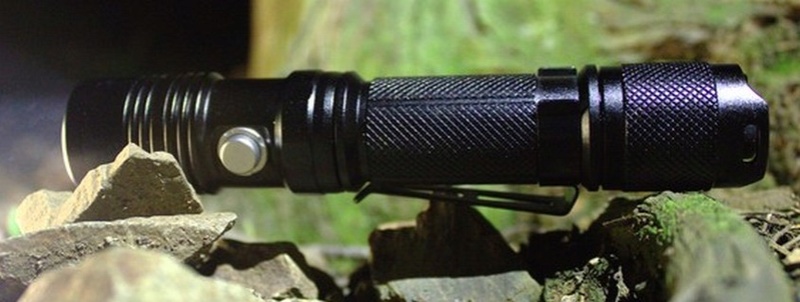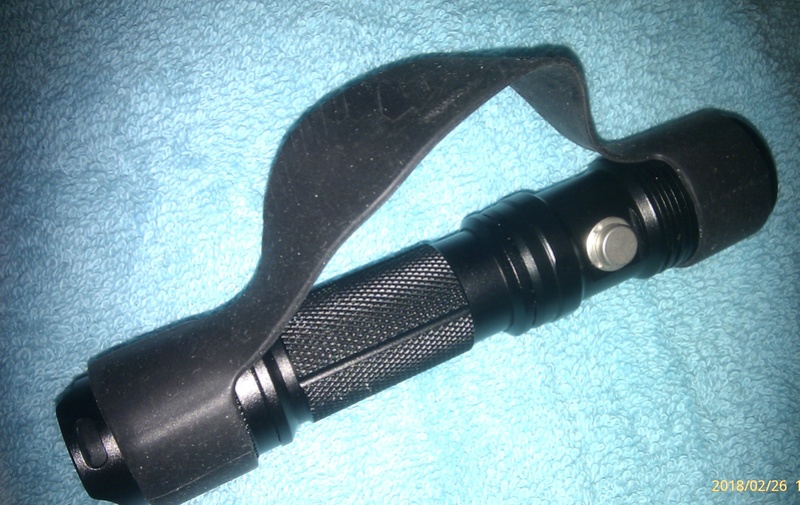THE SHOOT LIGHT
Late last year I attended the
Low-light Program presented by Shane, in Georgia. As I wrote in my AAR
In the past I owned two good Surefire "shooting lights" Unfortunately I had swapped my 6Z for an Inova and my 9P had stopped working. So, for this course I bought a cheap Chinese copy, with my compact Surefire E2e in reserve. For illumination the light was OK, but it was equipped with the dreaded "reverse-clicky" switch, which confusingly, illuminates when you release the pressure. In the drills this was less than ideal, and I will be buying a more suitable light in the near future. The reason I wanted to use a full size light, rather than my E2e, was to work with the Graham Combat ring, which I have found in the past to be very practical.MY FIRST SHOOT LIGHTWhile working on this article, I remembered my first ever shoot light I joined Aintree Pistol Club in 1974, and was issued my firearms certificate in April 1975. At about the same time a group of like-minded entusiasts, who had been reading Colonel Cooper's columns, started a Practical section. Steve Jahme-Smith, who later succeeded the Colonel as President of IPSC, organized a series of monthly shoots, which he called "Advanced Combat Teams", Basically, a scenario based on the prolific terrorist outrages of the time, which had us enter a surprise situation as a two-man team, requiring tactics as well as shooting skills. One such test was a low-light situation, and I equipped myself with a US Army right-angle flashlight, clipped to my jacket, as a shoot light. It was a woeful solution, but underlined to me the importance of flashlight aided shooting..
SHOOT LIGHT TASKSUpon returning home from Georgia,I decided to upgrade my flashlight, and started by defining what is required in a "shoot light"
While we carry a flashlight for a variety of tasks, searching for lost items, checking for obstacles on broken ground, signalling to responders etc, the shoot light has a very specific function, and some great general-purpose lights are not suitable for flashlight-aided shooting.
The shoot light is mainly used to:
Locate
Identify
Disrupt
Engage
LOCATE
We can encounter low light situations in a variety of ways. We may be outdoors at night. We may go from daylight into a darkened structure. We may be within a building when the lights go out. In these situations we need to locate a safe route to follow, areas of egress, chokepoints, and, most importantly, potential threats
IDENTIFY
We are legally and morally obliged to positively identify [PID] any threat before delivering force. This is a vital element. Engaging a threat in a dark environment, without a flashlight to aid PID is a tragedy waiting to happen.
DISRUPT
Centuries ago the Dark Lantern technique was taught, against sudden night attack.

The good guy carried a lantern which emitted only a dim glow to light the way. Confronted by a looming assailant, the shutter was triggered to allow the full glare. Now if a candle will dazzle dark-adapted eyes, how much more effective will our current powerful lights prove? The optic nerve is directly linked to the brain, and a sudden burst of light can be a great way to interrupt the OODA loop, and buy the good guy precious moments as he goes through the decision process.
STROBE
Some suggest that a strobe function is desirable for this, and some lights have split pressel switches to allow the option of strobe, but I find this complicates the process.The strobe does not work well in navigating around obstacles, or, for identifying the threat. The disorientating effect of the strobe may also have been exaggerated somewhat. Anyway, if you want a strobe just rapidly work the tailcap switch.
ENGAGE
By aligning the light and the pistol in one of the currently taught techniques, the target is clearly seen and identifies, and the pistol sights are also highlighted, allowing very precise fire.. Night-sight inserts are great, but they do not aid in locating or identifying the threat. The flashlight, and appropriate training, are essential.
SHOOT LIGHT DESIGN FACTORSThe shoot light should have the following functions:
1] MOMENTARY SWITCH
Back in the day we used large, four-cell Maglites [or similar], but the current state-of-the-art is the compact flashlight, which is held in the "icepick grip" with the thumb operating the tailcap switch. Tactics require very brief flashes, followed by unpredictable movement, to avoid the "lighthouse effect" where you a a beacon to any lurking assailants. Under stress it is all too easy to jab the switch locking the light on. Some lights have the tailcap as only a momentary option, with the fully locked-on being a separate twist action. Some allow the degree of force to be varied by pre-setting the twist cap. Some lights have crenellations, and these act as a shield to help prevent inadvertent locking

As mentioned above, the design to avoid like the plague is the "reverse-clicky" which is detrimental to the whole concept of a shoot light.
2] BRILLIANT BEAM
Compact lights are becoming ever more powerfull. The LED has surpassed the incandescent bulb as state-of-the-art, being both dazzling and sturdy.
A general purpose flashlight might offer several levels of brightness, by various switching options, but the shoot light requires just one consistant, brilliant beam.
3] BATTERY LIFE
The light may be carried for long period, then used in a life critical situation. The batteries must be reliable. Many lights use the CR-123 which offers longevity, but a rather limited runtime. Other lights use AA cells which can offer many hours of use,. Whatever power units are selected have a regimen of tesating the light prior to carriage, consider carrying spare cells.
4] ERGONOMICS
The body of the light should allow the use of the concurrent techniques. Some lights are cluttered with fins and switches, preventing a full and consistant grip.
The light must have a dedicated carriage system, such as a Kydex pouch, which allows rapid access from the belt.
TASK LIGHTThe shoot light is, obviously, a very specific tool. We tend to use flashlights for a variety of none-shooting situations, so it may be wise to carry a second "general purpose" light, often known as a "task light"
Some of the qualities needed in a Task Light include:
1] ENDURANCE; a long battery life, for catastrophic situations, as discussed in our
London bombings - readiness gear thread.
2] VARIED BEAM. Some situations require a super=bright beam, while others need minimum illumination. In fact, sometimes too bright a beam can bounce back off walls, and actually dazzle the user. Switching between power levels should be user friendly.
3] ROBUST. The light should be drop proof, and able to function in austere environmental conditions.
4] STROBE. Can be useful for signalling your location.

Several years ago I adopted the Fenix L2D as my everyday Task light, and it is still serving me well. All I now needed was a new Shoot light, and with the above factors in mind I looked for a light, in a reasonable price range, and settled on the
Thrunite TN12, which was listed by Amazon at £37
While awaiting it's arrival I was sorting through my box of spares and found an aftermarket tailcap which I had picked up years ago.

This fitted my old Surefire 9P, and so I had that working again. I then had the bright idea to check if the G&P unit fitted my cheap light I had used in Georgia, and it did! So I now had the option of a light which was already equipped with the Graham Ring [see below], fits the Surefire belt pouch, and now has a really practical momentary switch.
MY NEW SHOOT LIGHT
The package arrived, complete with some accessories, including a lanyard, spare pressel, o-rings serviceable pouch etc
The light is a "clean" profile with no flutes and ridges, allowing a very positive grip.
The package doesn't include batteries, but I always have a supply on hand, and I inserted the requisite two CR-123 batteries, hit the pressel, and was amazed at the brilliance of the beam. This is the most powerful flashlight I've ever owned.
The great thing about the Thrunite is that it functions equally as a shoot light and a task light, obviating the need to carry two lights.

There is a second switch, on the barrel, which allows you to select brightness levels ranging from "Moonglow" to that blazing "Turbo" A constant pressure on this switch gives you a very rapid strobe. The great thing is that you can select the level which operates from the tailcap, so as a Shootlight, leave it set for
Turbo.
A Shootlight requires a pouch for reliable access. I was fortunate in finding a generic polymer unit which fitted perfectly.
 INTERFACE ACCESSORIES
INTERFACE ACCESSORIES
Utilising the light and the pistol together necessitates both hands being occupied, and this makes such tasks as clearing weapon malfunctions, opening doors, or, operating a radio problematic. There are a number of add-on options which alleviate this problem.
LANYARD
Surefire offered their 6Z with a purpose-designed lanyard. I found the concept useful, when I had a Zulu, and I made lanyards for several other lights, from shock-cord and cord locks.

The only drawback is that it takes two hands to slip the lanyard around the hand, thus making the presentation of the light a bit more complicated. It remains, however, a very useful addition to a task light, and my everyday Fenix has a lanyard, which also serves to secure it in the waistband.
GRAHAM RINGS

Designed by Matt Graham, who was a Federal Air Marshal at the time, this ring obviates the problem of the lanyard. Made of a hard rubber sleeve and loop, the device secures the light to the hand most conveniently. Access is smooth; as you grip the light your finger naturally finds the loop, and actually assists in withdrawal to the desired position. The ring allows full manipulation, for stoppages etc, and if you fall, you won't lose the light from your hand.
I've read speculation that the ring could cause damage to the finger during severe physical confrontation. I suppose it is a possibility, but, for me, the advantages far outweigh this risk.
There have been several other types of ring offered by various companies:
 [Quark ring]
[Quark ring] [Raven ring]
[Raven ring] [Self made ring, using rubber grommet]
[Self made ring, using rubber grommet] [Low profile carriage, using O-ring]
[Low profile carriage, using O-ring]THYRM
 [Even the manufacturers are confused by the clip]
[Even the manufacturers are confused by the clip]I bought the above device from Amazon, turns out it is a copy of the Thyrm Switchback device. I haven't evaluated the Thyrm unit, but this copy seems to have a couple of problems. It seems to me that the clip is on the wrong side for access from a pocket. Also, the lip inside the ring means that it must be fitted between the tailcap and barrel, which excludes several designs.
 [The original Thyrm Switchback]
[The original Thyrm Switchback]The Switchback was created to be used in the Rogers grip, a method I don't favour.
A different approach is the rubber band offered by Quark.

It fits my new Thrunite exactly, and makes the light easily accessible from the pouch. All in all, a great bit of kit for a Shootlight.
 FINAL THOUGHTS
FINAL THOUGHTSFor most people a Task Light is ideal. However, for those who carry a pistol on a daily [and nightly] basis a dedicated Shoot light can be essential. I intend this article as food for thought. My solution will not suit everyone, and there are numerous other great lights out there.
LINKSThrunite flashlightFlashlight pouchGraham Combat RingsRubber handgripFlashlight aided shooting forum thread